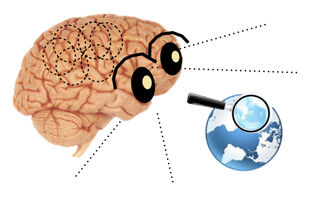Shyness
Why Shy?
Negative expectations make you shy, but you can build positive expectations.
Posted October 20, 2020

Shyness involves negative expectations about social interactions.
You expect a bad reaction when you speak up, and cortisol is released. You don’t intend to think this way, and you don’t even think it in words. Our limbic system works without words. It alarms you with threat chemicals when you see a situation that triggered threat chemicals in your past. Neurons connect when cortisol flows, which turns on the bad feeling faster in similar situations.
Positive expectations work the same way. Neurons connect when happy chemicals flow, which wires you to turn on the happy chemicals faster. You may wish you got that positive wiring. You may think others have it easier. But social interactions are hard for everyone because it's hard to predict new situations on the basis of old ones. We need negative expectations as well as positive to navigate the social world. If you only had positive expectations, you would make blunders that got you into trouble.
Yet overly negative expectations bring trouble too. You may miss out on social rewards because you don’t take social risks. Worst of all, you don’t know you’re doing this to yourself, so you feel like a victim. Fortunately, you can build new neural pathways to enjoy more positive expectations about social interactions.
Here’s a simple example.
I grew up with a lot of criticism, so my brain easily imagines criticism. When I leave a room, I can imagine people saying bad things about me. One day, I found out that something good had been said about me. Suddenly, I wondered how much good I had missed. How much unnecessary suffering had I created with my brain’s automatic response?
I decided to consciously change that. I made a habit of imagining something good said about me whenever I left a room. This may seem fake, but my negative expectations were fake too. I needed to offset them with some positivity to get closer to the truth.

You can do this too. First, learn to notice your negative thought loop, and then design a positive loop to offset it. It might feel phony or even arrogant to think something positive because old pathways are powerful. They have trained you to keep your guard up, so you don’t feel safe when you let in the positive. But that first tiny positive thought can make the next positive thought easier.
Soon, you will have a real positive social interaction. Your happy chemicals will surge and pave the pathway to release more of them. You won’t get a positive response all the time. You will live with frustration and disappointment like everyone. But you will take more social risks and learn from the results, so you will end up with more social rewards.
Here’s another example.
While giving a speech, I noticed that my gaze had settled on a person with a scowling face. I noticed this again during another speech. I was shocked to realize that my attention was drawn to scowling faces. I created a scowling world with my old neural pathways. But I was liberated when I realized that I was doing it to myself. I trained myself to scan for happy faces instead.
We stress ourselves with old pathways more than we realize.
Your love life can be ruined by a thought loop that says, “They always do this to me.” Your brain finds facts that fit because that’s the job it evolved to do. You miss out on the rest of the story. But you can train yourself to notice your negative thought loops and build some positives. At first, you may insist there are no positives available, but each tiny positive step makes the next step easier.
Your work life depends on your thought loops too. You can easily find evidence that your bosses and co-workers mistreat you. But you may miss out on the good when you zoom in on negatives. Fortunately, you can find one tiny positive before lunch and another before dinner.

It’s harder to change your wiring in adulthood. Lots of repetition is needed, and it feels foolish or risky at first. Instead of doing it, you may fall back on the belief that other people got lucky and your challenges are special. You may poison your life with cortisol when you think this. Instead, you can find your power over your brain. You’ll be glad you did!
Lots more on how to do this in my book, The Science of Positivity: Stop Negative Thought Patterns By Changing Your Brain Chemistry and at the Inner Mammal Institute website.




